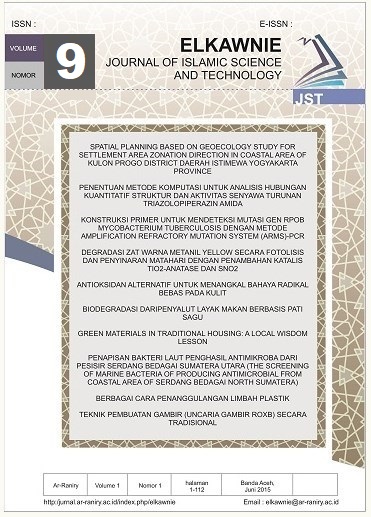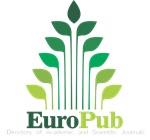Synthesis of Carbon Dots From Empty Fruit Bunch Biochar an Acid-Free Hydrothermal Method
DOI:
https://doi.org/10.22373/ekw.v9i1.14524Keywords:
Carbon Dots, Empty Fruit Bunch, Hydrothermal Methods, WasteAbstract
Abstract: Carbon dots have gained much interest due to their outstanding optical and electrical properties, making them useful for a wide range of applications. Here Empty fruit bunch (EFB) biochar was used as a carbon source in a straightforward, environmentally friendly, and reproducible hydrothermal method for producing carbon quantum dots. In this study, the role of the hydrothermal process was seen and studied by comparing the shape and fluorescence. Exciting results from HRTEM show that the carbon quantum dots in the sample are 4 nm in size. The obtained CD emits bright blue luminescence, and the absorption peak of the carbon dots was observed in the UV region with maximum absorption at 205 nm and 322 nm. The light CD shows an intense sky blue color upon illumination by a UV-light source at 365 nm. The intensity of the photoluminescence (PL) spectra sharply increases with decreasing concentration of carbon dots. Meanwhile, the CD exhibited excitation-dependence, photo-stability, and well dispersibility. These results suggest that the present CD are potential applications in optoelectronics and imaging.
Abstrak: Karbon dots telah menarik banyak perhatian karena sifat listrik dan optik yang luar biasa, sehingga dapat digunakan untuk berbagai aplikasi. Penelitian ini, menggunakan biochar tandan buah kosong (EFB) sebagai sumber karbon dengan metode hidrotermal yang ramah lingkungan untuk menghasilkan karbon dots. Hasil HR-TEM yang menarik menunjukkan bahwa sampel karbon dots berukuran 4 nm. Karbon dots yang diperoleh memancarkan sinar biru terang dan puncak serapan titik karbon diamati pada spektrofotometri Uv-Vis dengan serapan maksimum pada 205 nm dan 322 nm. Intensitas karbon dots menunjukkan warna biru langit di cahaya UV pada 365 nm. Intensitas spektroskopi luminesens meningkat tajam dengan menurunnya konsentrasi titik karbon. Sementara itu, karbon dots menunjukkan eksitasi, stabilitas, dan dispersibilitas baik. Hasil ini menunjukkan bahwa karbon dots dapat digunakan pada beberapa aplikasi seperti dalam optoelektronik dan pencitraan.
References
Ahmad, A., Rahmad, Rita, N., & Noorjannah, L. (2022). Effect of acid hydrolysis on bioethanol production from oil palm fruit bunches. Materials Today: Proceedings, 63, S276–S281. https://doi.org/10.1016/j.matpr.2022.02.461
Chang, K., Zhu, Q., Qi, L., Guo, M., Gao, W., & Gao, Q. (2022). Synthesis and Properties of Nitrogen-Doped Carbon Quantum Dots Using Lactic Acid as Carbon Source. Materials, 15(2), 466. https://doi.org/10.3390/ma15020466
Choi, Y., Choi, Y., Kwon, O.-H., & Kim, B.-S. (2018). Carbon Dots: Bottom-Up Syntheses, Properties, and Light-Harvesting Applications. Chemistry - An Asian Journal, 13(6), 586–598. https://doi.org/10.1002/asia.201701736
De, B., & Karak, N. (2013). A green and facile approach for the synthesis of water soluble fluorescent carbon dots from banana juice. RSC Advances, 3(22), 8286. https://doi.org/10.1039/c3ra00088e
Gea, S., Surga, M., Rahayu, S., Marpongahtun, Hutapea, Y. A., & Piliang, A. F. (2018). The analysis of thermal and mechanical properties of biocomposite policaprolactone/cellulose nanofiber from oil palm empty fruit bunches. 020063. https://doi.org/10.1063/1.5082468
González-González, R. B., González, L. T., Madou, M., Leyva-Porras, C., Martinez-Chapa, S. O., & Mendoza, A. (2022). Synthesis, Purification, and Characterization of Carbon Dots from Non-Activated and Activated Pyrolytic Carbon Black. Nanomaterials, 12(3). https://doi.org/10.3390/nano12030298
Han, Z., He, L., Pan, S., Liu, H., & Hu, X. (2020). Hydrothermal synthesis of carbon dots and their application for detection of chlorogenic acid. Luminescence, 35(7), 989–997. https://doi.org/10.1002/bio.3803
He, M., Zhang, J., Wang, H., Kong, Y., Xiao, Y., & Xu, W. (2018). Material and Optical Properties of Fluorescent Carbon Quantum Dots Fabricated from Lemon Juice via Hydrothermal Reaction. Nanoscale Research Letters, 13(1), 175. https://doi.org/10.1186/s11671-018-2581-7
Jamaludin, N., Tan, T. L., Zaman, A. S. K., Sadrolhosseini, A. R., & Rashid, S. A. (2020). Acid-Free Hydrothermal-Extraction and Molecular Structure of Carbon Quantum Dots Derived from Empty Fruit Bunch Biochar. Materials, 13(15), 3356. https://doi.org/10.3390/ma13153356
Liu, J., Li, R., & Yang, B. (2020). Carbon Dots: A New Type of Carbon-Based Nanomaterial with Wide Applications. ACS Central Science, 6(12), 2179–2195. https://doi.org/10.1021/acscentsci.0c01306
Liu, Y., Yong, C., Tong, B., Li, Y., Wang, N., & Lei, Y. (2022). Modification of carbon dots derived from biomass by exogenous nitrogen doping: Action mechanism and difference analysis. Optical Materials, 134(September). https://doi.org/10.1016/j.optmat.2022.113144
Marpongahtun, Gea, S., Muis, Y., Andriayani, Novita, T., & Piliang, A. F. (2018). Synthesis of Carbon Nanodots from Cellulose Nanocrystals Oil Palm Empty Fruit by Pyrolysis Method. Journal of Physics: Conference Series, 1120(1), 1–6. https://doi.org/10.1088/1742-6596/1120/1/012071
Pandiyan, S., Arumugam, L., Srirengan, S. P., Pitchan, R., Sevugan, P., Kannan, K., … Gandhirajan, V. (2020). Biocompatible Carbon Quantum Dots Derived from Sugarcane Industrial Wastes for Effective Nonlinear Optical Behavior and Antimicrobial Activity Applications. ACS Omega, 5(47), 30363–30372. https://doi.org/10.1021/acsomega.0c03290
Rani, U. A., Ng, L. Y., Ng, C. Y., Mahmoudi, E., Ng, Y.-S., & Mohammad, A. W. (2021). Sustainable production of nitrogen-doped carbon quantum dots for photocatalytic degradation of methylene blue and malachite green. Journal of Water Process Engineering, 40, 101816. https://doi.org/10.1016/j.jwpe.2020.101816
Wang, Y., & Hu, A. (2014). Carbon quantum dots: synthesis, properties and applications. Journal of Materials Chemistry C, 2(34), 6921. https://doi.org/10.1039/C4TC00988F
Xu, D., Lei, F., Chen, H., Yin, L., Shi, Y., & Xie, J. (2019). One-step hydrothermal synthesis and optical properties of self-quenching-resistant carbon dots towards fluorescent ink and as nanosensors for Fe 3+ detection. RSC Advances, 9(15), 8290–8299. https://doi.org/10.1039/C8RA10570G
Yi, Z., Li, X., Zhang, H., Ji, X., Sun, W., Yu, Y., Sain, M. (2021). High quantum yield photoluminescent N-doped carbon dots for switch sensing and imaging. Talanta, 222, 121663. https://doi.org/10.1016/j.talanta.2020.121663
Downloads
Published
Issue
Section
License
Proposed Policy for Journals That Offer Open Access Authors who publish with the Elkawnie journal agree to the following terms:
a. Authors retain copyright and grant the journal right of first publication with the work simultaneously licensed under a Creative Commons Attribution License that allows others to share the work with an acknowledgement of the work's authorship and initial publication in this journal.
b. Authors are able to enter into separate, additional contractual arrangements for the non-exclusive distribution of the journal's published version of the work (e.g., post it to an institutional repository or publish it in a book), with an acknowledgement of its initial publication in this journal.
c. Authors are permitted and encouraged to post their work online (e.g., in institutional repositories or on their website) prior to and during the submission process, as it can lead to productive exchanges, as well as earlier and greater citation of published work (see The Effect of Open Access).

























